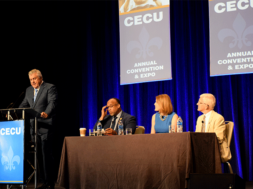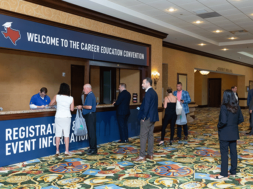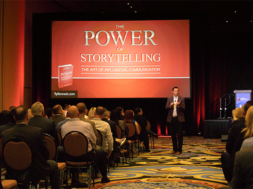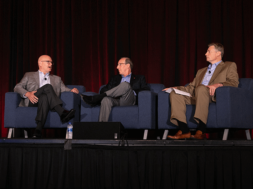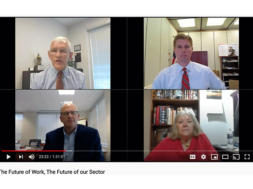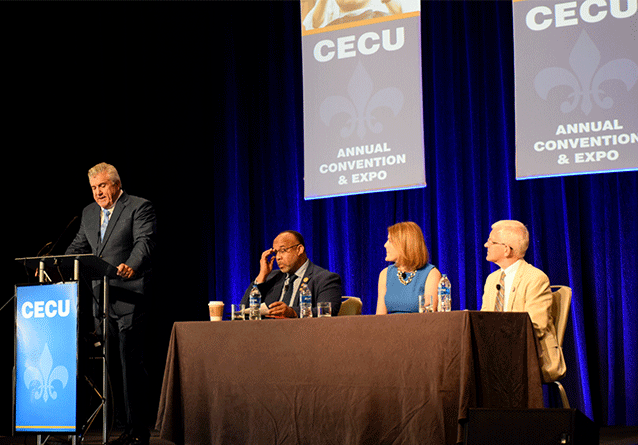
Keynote Speakers at CECU Convention: Highlight Innovation for a Successful Future
By Sara Klein, written from Career Education Colleges and Universities (CECU) Convention Sessions
The 2019 Career Education Colleges and Universities (CECU) Convention, working within the theme of “Innovation: Our History! Our Future!” was a successful meeting of the minds. Held in New Orleans June 2-4, the goal of the convention was to make sure school leaders had the tools and knowledge of emerging technology skills necessary for the workforce of tomorrow.
The convention provided four keynote addresses and more than 40 sessions, along with a diverse exhibit hall. The convention also delivered opportunities for networking and learning, so school leaders could return energized and excited for the new school year.
Congresswoman Virginia Foxx – Call yourself taxpaying institutions
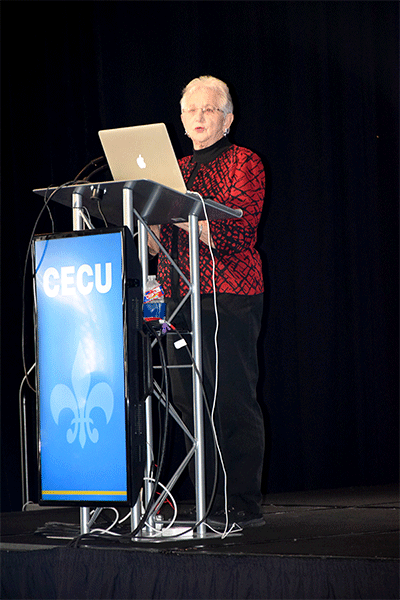
The opening session, headed by Congresswoman Virginia Foxx, held the underlying theme of accountability. Foxx started her journey the same as many students. She grew up poor and knew she could be successful if she could get an education. Her key philosophy is being a supporter of students and putting students first. Before becoming a member of congress, she was the Director of Upward Bound/Assistant Dean of Appalachian State University. While there, she treated her students like customers, an important part of her philosophy. “I worked full time, went to school part time, had a child and managed to get my degree,” she said. “You’re the kind of people who are helping those parents who are working full time, taking care of kids and trying to improve their lives by going to school. I want to support what you’re doing, because we know education is not a frill, it is a necessity for us. As long as you’re doing that, as long as your focus is helping students, I’m going to be your friend.”
Foxx went on to discuss how much opposition to this sector of education there has been recently. She explained the reasons for the attacks on for-profits, which is the high level of debt and then students being unable to finish their programs. “They’ve lost what is more precious than money, and that’s time. What you do for most students is give them the luxury of time by helping them meet their goals,” Foxx said. “I think the tide is shifting against the status quo. I think there’s a real revolution coming and it’s focused on skills education.”
Foxx went on to note how, from the opposition, just the words “for-profit” are seen as dirty words. To this she says, “I want you to start saying we’re a taxpaying institution.”
She went on to explain how all five hearings to discuss preparations for the Higher Education Act (HEA) have deteriorated into attacks against for-profit colleges, with the wish to have for-profit education out of the picture. “I want accountability…from everyone. That’s what we should be having in this country,” Foxx said.
She continued with the need for skilled workers. “Every member of Congress has a business in his or her district that is scrambling to fill jobs,” Foxx said. “It makes no sense to lock out a segment of the education community that can provide the people with the skills they need to complete their jobs.” She urged the audience to communicate with their members of Congress and let them know how for-profit universities are able to educate for these necessary skills. “Business and industry are starting to set up their own education programs. They’re going to leave you guys behind if you’re not careful,” Foxx warned. “You need to look at where the industries’ big jobs are and start partnering with them. You need to be looking for those opportunities [to educate where the needs are]. There are 7.1 million jobs in this country right now that are unfilled. People are desperate to find folks for that.”
With the HEA’s future unknown, Foxx recommended continuing to focus on students. “I’m going to do everything that I possibly can to bring us into the 21st century when it comes to education,” she explained. “You represent so much of the good that we need to be doing. It’s really important that you continue to focus on students and you continue to focus on skills education because the world is finally catching up to us.”
Foxx ended with a warning to the audience to not spend all their energy on playing defense. “Focus on the important things,” she suggested. “Go out there and proudly tell your story.” She urged everyone to tell their story to business people, legislators, and the chamber of commerce. “Put your students first,” she reminded. “As long as you do that, you’ll have nothing to apologize for and you will be able to help us change the world for the better. That’s what we have to do. Focus on what you’re doing locally, because that’s where it has to start.”
Jim Carroll – Change your future before the future changes you
The second keynote session on Monday was all about different ways career schools can prepare themselves for the jobs of the future. Jim Carroll, a leading global futurist on industry and sector trends, gave his take on how to navigate the future of education, given the fact that the current era is fraught with changes with new careers emerging and existing careers disappearing at a rapid rate. Carroll has over 25 years invested in researching changing trends and high-velocity innovations in order to inspire companies and educational institutions to adapt to the rapidly changing needs of the future.
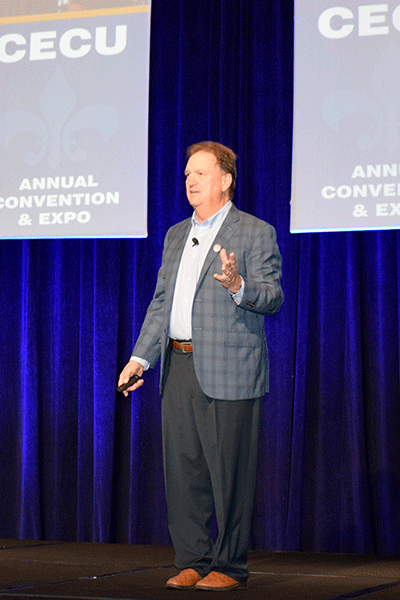
Carroll framed his discussion around a series of rules about how to interpret the future. He pointed out that it’s tricky to have to deliver knowledge for careers that do not even exist yet to people who don’t even know they will be needing these skills. To do this, it’s important to understand the rules of the future. His first rule of the future is “the future happens; any trend that you hear about eventually happens,” Carroll said. “We have a tremendous challenge today in determining the timing of any particular trend.” He went on to discuss a current trend, which he labeled as profound for our time, which is the blockchain concept. Carroll feels this will impact every single career, profession and skilled trade and the delivery of curriculum based on blockchain concepts is the way of the future.
Carroll continued with the blockchain concept by acknowledging that history repeats itself. “While bitcoin might be one of these virtual bubbles that we’ve seen throughout history, blockchain is real,” he said. “I go out and talk to every single industry out there about where we are going in the future, about what is unfolding, about the challenges that are coming about as we lead into this complex and integrated world.” And blockchain technology is what is coming. He gave examples of how it will be used in the construction sector with 3D printing and robotics and how it will be used in the energy sector. “Herein lies the challenge with the future,” Carroll said. “We have a trend, but when we’re at the early stages with the trend, it’s all too easy for us to conclude that it isn’t real.” That’s when the first rule of the future comes into play. “The future happens eventually,” he repeated. “So you need to be cognizant of these trends.”
Carroll then went on to discuss his second rule for the future, which is that the future is way bigger than we ever expected it to be. There is a transformation occurring right now, which some people see as negative since so many jobs and careers are disappearing. “But at the same time, we are witnessing the emergence of millions of jobs, millions of new careers, millions of opportunities,” Carroll explained. “It is your role to deliver the knowledge that will provide for these careers going forward into the future.” He continued by saying that education itself needs to change. Training people for skills that will soon be out of date is no longer the best practice, but “training them with the ability to get the right knowledge at the right time for the right purpose for the right situation for a fast, emerging micro-career opportunity” is the new way to prepare students for this future. “You [now] find yourselves in a world in which you are instead developing the delivery and skills for just in time knowledge,” Carroll said.
Carroll’s third rule about the future is that it happens slowly then all at once. “We’ve got the emergence of so many unique trends – artificial intelligence, virtual reality, 3D printing, the internet – that it’s almost like the imagination machine of people worldwide is being turned on,” Carroll said. “We are in a world in which the inconceivable suddenly becomes conceivable and it happens just like that.” To further illustrate his third rule, Carroll provided an example from when he spoke at the American Association of Orthopedic Surgeons. “I was talking about the fact that we are in a world in which increasingly the opportunity to 3D print a prosthetic arm has become a reality,” he said. “Three minutes before I go on stage, I’m going through my Twitter feed and there I see a post, not just about the 3D printing of a prosthetic arm, but the 3D printing of a robotic prosthetic arm. I’m having a hard time keeping up, because the future is coming at us with such steady speed.”
He continued with more real-world examples in the world of drones, discussing the new career of drone mapping consultants. Now drones are able to give information on quarries to provide inventory analysis. Drones can fly over a golf course and give detailed heat maps on turf health and other environmental information. He also discussed the changes in agriculture. “How many of you are delivering an education program in the agricultural sector based upon spatial intelligence farming ideas? Not many of you, I bet,” he said. “All of a sudden we’re in this world in which the typical acre of corn is putting off five gigabytes of data a year because we can determine disease, humidity, plant health, nutrient levels. The entire future of agriculture has become a technology-driven industry, driven by drones.” This technology, Carroll further illustrated, even goes so far as to have Fitbits for cows, which can measure their health among other data, also read by drones.
He went on with the example of truck technology, with the adage that there is so much technology engineered into the typical truck today that it contains more than a Cessna jet. He discussed how Volvo and Mack trucks had to change their sales and maintenance strategies because of this new technology. “They are at the point where they have engineered so much predictive diagnostics into their trucks that they’re no longer selling the truck; they’re selling a service level lifetime guarantee,” Carroll said. “They now know when a particular truck is going to breakdown and they’re going to tell you when to bring it in for preventative maintenance. If they’re doing that before you send that truck out for delivery in the remote desert of Arizona, that’s worth a lot of money.”
Carroll cautioned on the importance of being ready for this new, scientific and drone-filled future, or run the risk of being left behind.
“I do know that you need to prepare yourself for a world in which the future belongs to those who are fast,” he warned. “It’s the disappearance of existing careers, the rapid emergence of new careers, the fast emergence of new micro-careers, which last for only a short period of time, and the acceleration of the need for just-in-time knowledge, an increase in the number of nomadic workers – people who will have 35 or 40 different careers throughout their lifetime and workers who fundamentally challenge the very nature of the organization.” He gave three pieces of advice to help the sector be ready for this new future and be the training centers the industry needs. The first thing he advised to do is align with industry, urging schools to go to industry association events and listening to what the speakers discuss in terms of future careers and skills. “You need to be more aggressively involved with industry because they’re realizing they’ve got a big problem, and you are the toolbox that can help them to solve that problem,” he said. The second suggestion he gave was to be more aggressive in co-op education by getting more students out in the field working with organizations. The third tip he gave was to change the way curriculum is thought of. “The concept of curriculum is old. It’s dead. It’s obsolete,” Carroll said. “What you need to do is provide people with the skills and the knowledge to get the right knowledge at the right time for the right purpose for the right situation. You need to do it fast.”
He ended the session with an overview of his personal philosophy. “Change your future before the future changes you,” he said. He asked the audience to reflect on what they are doing to align themselves to the future. “What are you going to do rather than recoiling from these trends in fear and considering the practical reality that we might see millions of truck driver jobs outsourced overseas? It is going to happen. What are you going to do to turn that into an opportunity with the millions of jobs that will emerge as this comes about?” he asked. “Change your future before the future changes you. To do that, you adopt this simple mantra: Think big, start small and scale fast.”
Bridging the job gap in the healthcare and manufacturing fields
The first session on Tuesday focused on the large job gap in the healthcare and manufacturing fields and what career schools can do to help bridge this gap. The session was hosted by Dr. Sheldon Fields and Ms. Carolyn Lee, with an introduction from Mr. Joe Martin. Dr. Fields is a healthcare career trends expert and Ms. Lee is a manufacturing trends expert. Together they presented the need for more skilled workers in their respective fields, with Dr. Fields beginning the discussion in the sector of healthcare.
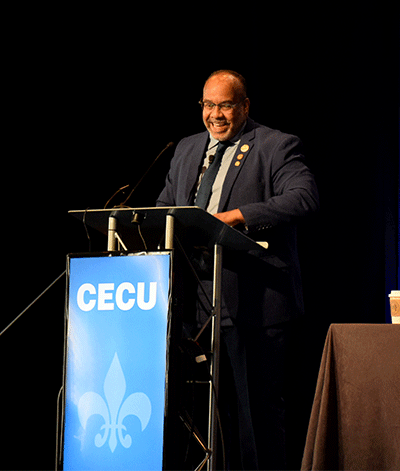
Dr. Fields began his discussion by pointing out the growing changes in the population in relation to healthcare. He discussed how there will be 84 million people over the age of 65 by 2050, using their Medicaid and Medicare eligible services, which will make a huge demand in the market. Along with aging is a growing ethnic and racially diverse population. “The whole issue of healthcare with a cultural relevance becomes an important point in terms of what will the healthcare workforce actually look like,” Fields said. “While [these populations] are going up, the number of openings far exceeds the supply.” He explained that traditional colleges and universities will try to fill that gap, but they don’t always get the mix right.
He went on to discuss the annual job openings in healthcare, which total 1.62 million, with about 200,000 of those being nurses. “You always hear about a nursing shortage. What you don’t hear about is what fuels that nursing shortage is a lack of nursing professors to teach those students, and the fact that the nursing profession actually turns away about 40,000 students every year,” he said. “We tell them we don’t have room for you and then we tell a certain segment that they aren’t worthy to be a nurse. I think that part really is egregious. Then we wonder why we have a nursing shortage.”
At a Glance: Dr. Sheldon Fields
Dr. Sheldon Fields, a Healthcare Career Trends Expert, has over 25 years of experience with research in nursing higher education as well as health policy analysis. He also was the first-ever male RN selected for the Robert Wood Johnson Foundation Health Policy Fellowship program, where he worked in Washington, D.C. for U.S. Senator Barbara Mikulski on the Senate Committee on Health, Education, Labor and Pensions, as well as the Subcommittee on Aging during the reform debates with the 2009 and 2010 passage of the Affordable Care Act.
He continued by discussing the changes in standards for current nursing programs. Before, about half of the nurses received entry-level RN status with just an associate degree, but that has changed. “The large number of folks are going back to get their baccalaureate degree in RN BSN programs that exist in a lot of schools,” he explained. He discussed how New York just passed a law that states nurses with only an associate degree must get their baccalaureate degree within 10 years or they lose the right to practice. He doesn’t believe, however, that individuals with just an associate degree should be disenfranchised. Instead, he urged schools to create a pathway for those individuals. “We’ll need institutions like yours to help us create those pathways, because again it’s about how do we put people through the system in a meaningful way,” he said. “If we don’t create pathways at the entry-level point, we’ll never get a sufficient pipeline to even talk about doing advanced practice.”
He continued with the different ways the career college sector can help this field, discussing how not being bound by overregulation like traditional institutions can prepare healthcare professionals in more ways by just thinking outside the box. “The need to develop a more effective and efficient healthcare workforce is tantamount,” he said. “There’s a great deal of opportunity for your institutions to help fulfill this overall growing demand for healthcare professional education. You all provide that critical access to many who are seeking entry at the entry-level.”
He offered a challenge to the members of the audience to design their programs to be community participatory in order to get local support for their institutions. “Think about how you design to work for non-traditional populations. People automatically think I have to do it online, but online education is just one way,” Fields said. “There’s also evening and cohorts and different support groups. It’s things like that and thinking outside of the box that I really want to challenge you to do.”
He ended by talking about how the overall trend for healthcare is remaining positive. “The aging and diverse population changes will continue to drive the need for healthcare professionals with a variety of skills,” Fields stated. “Nursing, personal care aides, in-home health needs will continue to lead the market. Opportunities for career education colleges and universities abound. The service is critical in in-demand areas.”
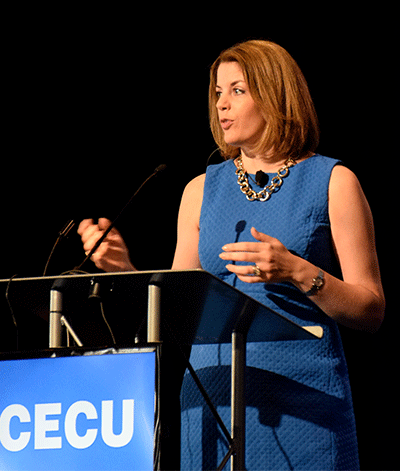
Ms. Carolyn Lee then took over the podium, discussing the manufacturing sector and what the industry is looking at when it comes to the manufacturing future. She points out that there are many ways to become educated, be it a four-year degree or a two-year degree or a certificate. All of them are needed to fulfill the manufacturing opportunities, jobs, and careers that are available. “We need every single pathway we can get. We need people with skills, and we don’t have a preference or a hierarchy of what those skills are and how you receive them,” Lee said. In order for this to happen, life-long training is often necessary, with students needing to go back to school throughout their careers to learn more skills. “We need to change the value proposition of that,” Lee said. “We can’t do that alone as an industry. We need to work with you in order to accomplish that.”
Lee went on to discuss the changes to the manufacturing sector of today and how different it is to what manufacturing was in the past. It has an entirely different look and feel. The Manufacturing Institute that she is the Executive Director of has the mission to educate, excite, and empower by focusing on women, veterans, youth, and lifelong learning. “We need to do this because the future of manufacturing depends on our ability to recruit and retain the workforce that we need to make the things that we do every day here in the U.S.,” Lee said. “We need to be able to recruit a diverse workforce.”
Lee continued to discuss the manufacturing sector and its needs due to the wide gap of open jobs and lack of a skilled workforce to fill them. She said how there are about 500,000 open jobs in manufacturing today and how the Manufacturing Institute, in partnership with Deloitte, has done the landmark study on the skills gap in manufacturing. “The most recent skills gap study came out last November and what we found is that we actually had worse news than we did in the past,” Lee explained. “We had 4.6 million jobs that would need to be filled in the manufacturing sector between 2018 and 2028. It is expected that 2.4 million will go unfilled.” This problem is something the manufacturing sector needs career colleges to help solve, and the challenge is important because of the impact on the economy. “Having 2.4 million manufacturing jobs unfilled means a 2.5 trillion worth of GDP risk to the economy,” Lee explained. “Manufacturing jobs have more benefits than typical other jobs, with almost $85,000 as the annual compensation. So the value of these jobs to communities, families, and individuals are significant and if we don’t sell that, that’s a huge drain on our economy.”
At a Glance: Carolyn Lee
Ms. Carolyn Lee, a Manufacturing Trends Expert, is the Executive Director of the Manufacturing Institute, which is the education and workforce partner of the National Association of Manufacturers, the nation’s largest industrial trade association. She leads the institute in its goal of preparing the manufacturing workforce for tomorrow while supporting the workforce of today through a number of programs designed to excite, educate and empower, with a focus on the four key areas of Women, Veterans, Youth, and Lifetime Learning.
Lee further explained that while we have 75 million workers at risk for losing their jobs to automation by 2020, there is also the opportunity to create 133 million jobs over that same time if career schools teach the right skills and develop that next generation of skilled workers. She talked about how automation has actually helped the manufacturing sector due to the physical demands being less with automation helping move the equipment around, which allows the sector to attract a diverse population. She discussed how, in order to fill this gap, the sector needs to talk to students, high schools, parents and teachers. “National manufacturing day is a program that the Institute maintains,” Lee said. “It is a grassroots program across the country. We had 3,000 events last year, where manufacturers and schools open the doors and bring in the community to show them what modern manufacturing looks like, and help them understand the career tracks, the career pathways for local jobs.” She further explained that by showing students what manufacturing looks like will help energize and drive students’ choice in careers. “We show students what we have through a nationwide network of youth engagement partnerships called our Dream It, Do It program,” she said. “So if you have a Dream It, Do It partner in your state, I’m happy to connect you to them and work with local companies to engage local youth to look forward to these jobs.”
She ended with the goal to make sure more people are connecting to rewarding manufacturing jobs. “We need to talk about what the opportunities are that come from learning these skills and learning this fluency in the STEM careers and the opportunities of the future,” Lee said. She explained how manufacturing jobs stay around. The plants don’t just disappear on a whim, but are instead big investments in communities with plans to stay there for a long time. She also explained how the focus isn’t on the big manufacturers, but the small and medium-sized firms, which make up about 90 percent of the sector in this country and are the supply chains needed for the brand-name companies like GE or Boeing. “It’s our job to help and we in the sector need your help as educational providers to make sure that we are working together to train for the jobs that we have. We need to make sure that we are together solving the local problem of the skills gap. Your local manufacturers have jobs that are hard to fill and they look to you to help them fill it,” Lee said. “Please engage with your local manufacturers. Engage with us – The National Association of Manufacturers and the Manufacturing Institute. We’re happy to be a resource for you, because together we can close the skills gap and make sure that our companies remain strong.”
Strategic plan for the future of the sector and the national association
The final keynote session held on Tuesday, June 4, was the annual meeting of the members. Their main focus was on the new strategic plan for CECU and its member schools. David Vice, CEO and chair of CECU’s board of directors, and Lynelle Lynch, treasurer, both spoke briefly before the video outlining the strategic plan was aired. Vice discussed the CECU’s top priority, which is advancing the sector’s voice in national public policy. He talked about how hard the team is working, which is harder than in any other time in history. “They are working under a more hostile environment, especially in the House of Representatives, where our opponents have organized a multi-faceted attack on our very existence,” he explained. He continued with discussing the last event of the year, which is the CEO Summit in San Diego, held Nov. 13 and 14. He ended with the benefits of CECU, which is the legislative advocacy and research to high-quality leadership events. Lynch finished the introduction by talking about the challenges the sector is facing in Washington, D.C. and how important it is to not hold back on working towards meeting those challenges. She told the audience how dues were not going to increase with the new budget that was just approved and how $857,000 of the reserves were being spent to support the strategic plan discussed in the video. “[This extra money] allows us to add two key positions to CECU. One is the Director of Veteran Affairs, and we know that this is a critical area for us to have an ongoing support and staff support for,” Lynch said. “The other is the Director of Communications so that we can help communicate better to all the schools and help you communicate better to the communities that we serve.”
The video began with a brief introduction by Vice, discussing the creation of a strategic plan for the future of the sector and the national association. The strategic plan was created by five different working groups who met monthly to develop their recommendations.
The first group was the membership working group, co-chaired by Florence Tate, a public member on CECU’s board of directors, and Mel Weiner, President of Mandl School, a college of Allied Health.
“We must create a strong, stable, and national voice for this sector through membership,” Tate said. She urged the current members to communicate to the rest of the sector the many benefits schools receive from CECU’s work.
“We also must embrace and own the campaign to create 5 million career professionals in this decade,” Tate said. “During the first two years, our schools have created about 1.3 million new professionals. We must brag about this.” Weiner agreed, recommending a new level of engagement and partnership by allied members in the membership effort. He asked for the creation of a series of innovative membership opportunities, since in this world, one form of membership is not sufficient. He offered a number of options, which included inviting state associations to work with the sector in developing a joint membership to attract schools who currently don’t belong; developing a five-year maturing membership, where schools can grow into full membership over time; reaching out to both private non-profit and public schools to engage in the common educational mission; and adding individual membership for educational professionals. “We call upon CECU to add a new component to the current leadership institution that serves those currently in mid-level leadership roles within their schools,” Weiner said in an effort to bring more to the conference.
The second group was the communications working group, headed by Jean Norris, the allied member’s representative on CECU’s board of directors, and Valerie Cimarossa with the University of Advancing Technology. The recommendations of this group included two different communication strategies, one for the national association and one for the sector’s schools. “In each case, we really must communicate our sector’s role as a solution for skills demands, either nationally through CECU, or locally through each school,” Norris said. “Today the most effective communications are those happening at the local level, where each school can articulate their role in meeting their communities’ skill need.” Cimarossa continued by recommending an annual production of the messaging handbook, which provides an example of the kinds of data CECU must provide to schools to help them be better communicators. “CECU has produced some incredible research, which can be used effectively if used strategically at the school level,” Cimarossa said. She also urged the sector to get better at using social media. “To put it bluntly, we must do more, we must be better and we have to be more strategic about it,” she concluded.
The research working group was the third group, which was chaired by Duncan Anderson, the founder and CEO of Education Affiliates, and Art Keiser, the chancellor for Keiser University in Florida. Anderson discussed how research plays a critical role in advancing and defending the sector. His recommendation is for CECU to distribute the Gallup research work because “of its highly respected outcomes reflected in the collective work of our graduates,” Anderson said. He believes a lack of staff and resources caused this research to not be distributed as well as it should have. This research will help showcase the quality of the academic programs as well. “We call on CECU and every school in the sector as the national voice for transparency, with common outcomes data for every program at every school,” Anderson said. Keiser continued with the need for data to effectively tell the sector’s story, especially since the sector’s opponents manipulate the data in an effort to showcase the sector in a negative light. “The only way to counter such manipulation is by giving people the source data showing the sector is committed to serving low-income students and producing outcomes that match or exceed all of the sectors of higher education,” Keiser said. “CECU needs the professional capacity, either in-house or on contract, for rapid response. We live in a 24/7 world, and our research program must be designed to deliver in this environment.”
Employment engagement was the fourth group. Jim Bologa, the president and CEO of Porter and Chester Institute and YTI Career Institute, and Tim McMahon of the Triangle Tech Group, worked together to chair this part of the strategic plan and the need to engage employers as advocates for the sector. “We believe CECU and the sector can enhance our power and partnership through employer engagement,” Bologa said. He recommended the creation of a best practice guide for effective employer engagement. “Satisfied employers become our most credible voice in the conversations with policymakers,” he said. McMahon agreed, encouraging the need for strong employer partnerships.
“When the employer tells a policymaker that a school is essential to their business and their ability to compete in today’s environment – that means something. For this reason, our second recommendation is to engage employers as voices for our sector,” McMahon said.
“Every career school should build alliances with their state and their national associations in the industries to which they provide graduates.”
The last working group for the strategic plan was on government relations, and it was co-chaired by Nick Mansour, the president of the Arizona College of Nursing, and Sally Mikhail Bemis of Mikhail Education Corporation. Mansour discussed the need to improve communications to the government partners and also improve communication to its membership. Mikhail Bemis continued with the recommendation of a series of examples for enhanced government relations communications, stating a need for an additional staff person to support this work. “[These examples] include things like a preview of upcoming GR activities important to the sector, a plain English description of what happens and what it means for us, more stories introducing our congressional champions to the sector’s membership, and making government relations the primary topic of CECU’s website,” Mikhail Bemis said. She concluded with the need for more engagement in supporting friends in both parties and the recognition that many members wish to determine who they support with their personal dollars. “We also call for a merging of local fundraisers between CECU and their respective state associations,” Mikhail Bemis said. “Together we can do what neither of us can do separately – produce a stronger event and support the front.”
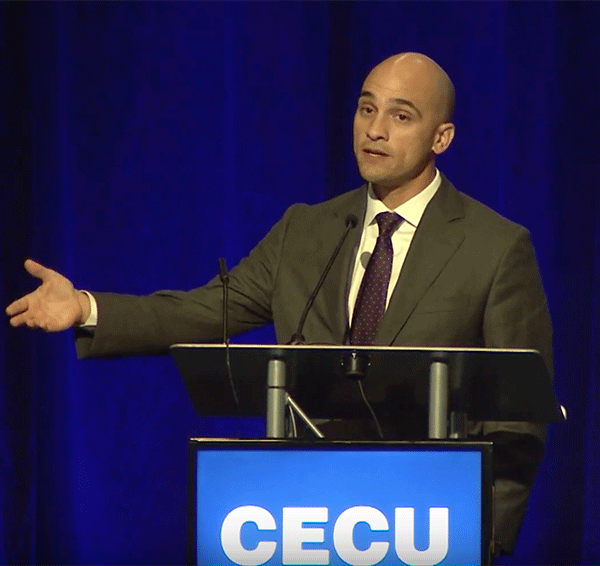
The meeting of the members concluded with Mike Dakduk, CECU’s Executive Vice President and Director of Government Relations, discussing Veterans for Career Education. He talked about how they’ve expanded the recruitment to over 100 military veterans so far, 30 who signed up to be student veteran ambassadors, who are the spokespersons for Veterans for Career Education. “They have said that I want to be a supporter and voice for protecting the right of veterans to use their earned benefits at the career school of their choice,” Dakduk explained. “They are willing to testify before Congress, offer op-eds and speak publicly.” He continued with how important this work is, and how it can directly impact policymakers in Washington, D.C. He also continued with how his team works offensively to persuade policy and how the political action committee helps them to support members of congress. He concluded with some ways in which the audience can help with the PAC’s fundraising efforts to keep this important work effectively moving forward.
The 2019 CECU convention provided a number of opportunities for educators to grow. With topics ranging from campus development, government relations, and marketing outreach, school leaders were given numerous opportunities to learn strategies and methods to engage their students in innovative ways to increase future success.
